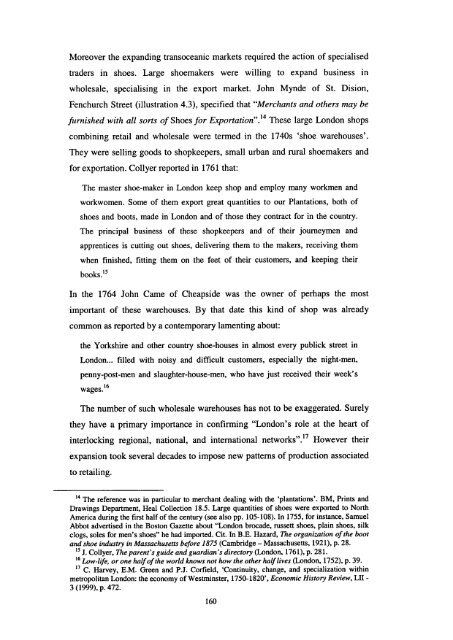The Boot and Shoe Trades in London and Paris in the Long Eighteenth Century
The Boot and Shoe Trades in London and Paris in the Long Eighteenth Century
The Boot and Shoe Trades in London and Paris in the Long Eighteenth Century
You also want an ePaper? Increase the reach of your titles
YUMPU automatically turns print PDFs into web optimized ePapers that Google loves.
Moreover <strong>the</strong> exp<strong>and</strong><strong>in</strong>g transoceanic markets required <strong>the</strong> action of specialised<br />
traders <strong>in</strong> shoes. Large shoemakers were will<strong>in</strong>g to exp<strong>and</strong> bus<strong>in</strong>ess <strong>in</strong><br />
wholesale, specialis<strong>in</strong>g <strong>in</strong> <strong>the</strong> export market. John Mynde of St. Dision,<br />
Fenchurch Street (illustration 4.3), specified that "Merchants <strong>and</strong> o<strong>the</strong>rs may be<br />
furnished with all sorts of <strong>Shoe</strong>s for Exportation".' 4 <strong>The</strong>se large <strong>London</strong> shops<br />
comb<strong>in</strong><strong>in</strong>g retail <strong>and</strong> wholesale were termed <strong>in</strong> <strong>the</strong> 1740s 'shoe warehouses'.<br />
<strong>The</strong>y were sell<strong>in</strong>g goods to shopkeepers, small urban <strong>and</strong> rural shoemakers <strong>and</strong><br />
for exportation. Collyer reported <strong>in</strong> 1761 that:<br />
<strong>The</strong> master shoe-maker <strong>in</strong> <strong>London</strong> keep shop <strong>and</strong> employ many workmen <strong>and</strong><br />
workwomen. Some of <strong>the</strong>m export great quantities to our Plantations, both of<br />
shoes <strong>and</strong> boots, made <strong>in</strong> <strong>London</strong> <strong>and</strong> of those <strong>the</strong>y contract for <strong>in</strong> <strong>the</strong> country.<br />
<strong>The</strong> pr<strong>in</strong>cipal bus<strong>in</strong>ess of <strong>the</strong>se shopkeepers <strong>and</strong> of <strong>the</strong>ir journeymen <strong>and</strong><br />
apprentices is cutt<strong>in</strong>g out shoes, deliver<strong>in</strong>g <strong>the</strong>m to <strong>the</strong> makers, receiv<strong>in</strong>g <strong>the</strong>m<br />
when f<strong>in</strong>ished, fitt<strong>in</strong>g <strong>the</strong>m on <strong>the</strong> feet of <strong>the</strong>ir customers, <strong>and</strong> keep<strong>in</strong>g <strong>the</strong>ir<br />
books.15<br />
In <strong>the</strong> 1764 John Came of Cheapside was <strong>the</strong> owner of perhaps <strong>the</strong> most<br />
important of <strong>the</strong>se warehouses. By that date this k<strong>in</strong>d of shop was already<br />
common as reported by a contemporary lament<strong>in</strong>g about:<br />
<strong>the</strong> Yorkshire <strong>and</strong> o<strong>the</strong>r country shoe-houses <strong>in</strong> almost every publick street <strong>in</strong><br />
<strong>London</strong>... filled with noisy <strong>and</strong> difficult customers, especially <strong>the</strong> night-men,<br />
penny-post-men <strong>and</strong> slaughter-house-men, who have just received <strong>the</strong>ir week's<br />
wages.16<br />
<strong>The</strong> number of such wholesale warehouses has not to be exaggerated. Surely<br />
<strong>the</strong>y have a primary importance <strong>in</strong> confirm<strong>in</strong>g "<strong>London</strong>'s role at <strong>the</strong> heart of<br />
<strong>in</strong>terlock<strong>in</strong>g regional, national, <strong>and</strong> <strong>in</strong>ternational networks".' 7 However <strong>the</strong>ir<br />
expansion took several decades to impose new patterns of production associated<br />
to retail<strong>in</strong>g.<br />
14 <strong>The</strong> reference was <strong>in</strong> particular to merchant deal<strong>in</strong>g with <strong>the</strong> 'plantations'. BM, Pr<strong>in</strong>ts <strong>and</strong><br />
Draw<strong>in</strong>gs Department, Heal Collection 18.5. Large quantities of shoes were exported to North<br />
America dur<strong>in</strong>g <strong>the</strong> first half of <strong>the</strong> century (see also pp. 105-108). In 1755, for <strong>in</strong>stance, Samuel<br />
Abbot advertised <strong>in</strong> <strong>the</strong> Boston Gazette about "<strong>London</strong> brocade, russett shoes, pla<strong>in</strong> shoes, silk<br />
clogs, soles for men's shoes" he had imported. Cit. In B.E. Hazard, <strong>The</strong> organization of <strong>the</strong> boot<br />
<strong>and</strong> shoe <strong>in</strong>dustry <strong>in</strong> Massachusetts before 1875 (Cambridge - Massachusetts, 1921), p. 28.<br />
' 5 J. Collyer, <strong>The</strong> parent's guide <strong>and</strong> guardian's directory (<strong>London</strong>, 1761), p. 281.<br />
'6 liw..le or one ha if of <strong>the</strong> world knows not how <strong>the</strong> o<strong>the</strong>r ha If lives (<strong>London</strong>, 1752), p. 39.<br />
17 C. Harvey, E.M. Green <strong>and</strong> P.J. Corfield, 'Cont<strong>in</strong>uity, change, <strong>and</strong> specialization with<strong>in</strong><br />
metropolitan <strong>London</strong>: <strong>the</strong> economy of Westm<strong>in</strong>ster, 1750-1820', Economic History Review, LII -<br />
3 (1999), p. 472.<br />
160


